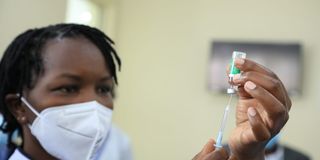Vaccine is no cure for Covid-19, experts say as roll-out begins

A nurse prepares a Covid-19 vaccine dose for administration at the Kenyatta National Hospital (KNH) in Nairobi, following the launch of the vaccination drive on March 5, 2021.
“Covid-19 vaccine is here. It is dose of hope in the fight against the virus but not cure. Do not lower your guard as the numbers are worrying,” Acting Health Director-General Patrick Amoth warned yesterday.
Kenya’s Covid-19 curve is swinging up, a red flag calling for more vigilance in observing public health measures.
On March 4, the country recorded a positivity rate of 6.2 per cent, a slight decrease from the previous data of seven per cent and 10 per cent on Thursday.
With an increase in the positivity rate and growing number of fatalities, experts have warned of a third and deadliest wave.
Could this be a sign of a new wave? At what point is a wave registered?
Dr Amoth said whenever the number of cases increases and the positivity rate is above five per cent, then there is a problem that should make Kenyans worried.
“An increase in deaths or cases means the virus is here. We need to adhere to the measures laid down and avoid infections. Even with the vaccine, we still need to mask up, sanitise, wash our hands and keep distance,” he said.
Prof Omu Anzala, a microbiologist, said waves may be different but an increase in the number of cases, deaths and patients who are critically ill is a sign of a developing wave.
Increase in positivity rate
For instance, Kenya has experienced an increase in positivity rate from as low as 3.5 per cent to 10 per cent.
Anything above five per cent is a danger, according to the World Health Organisation.
Some 378 patients were admitted to hospital countrywide on Tuesday, with more than 58 in the Intensive Care Unit.
Some 23 others were put on ventilator support and 29 supplemental oxygen. Six are on observation, according to the Ministry of Health.
“Things are not good. Kenyans have to go back to the basics and take care of themselves,” Prof Anzala said.
Going by the WHO standards, a country should have a positivity rate of five per cent and below for two or three consecutive weeks to be considered safe.
“The Covid-19 third wave is unfolding in Kenya. If not managed, the country will find itself in an intensified phase of community transmission. This can only lead to more hospitalisation and deaths,” Pathologists Lancet Kenya chief executive Ahmed Kalebi said.
Private laboratories
Pathologists Lancet Kenya is one of the private laboratories testing for Covid-19 in Nairobi.
Yesterday, Kenya recorded an additional 400 cases from a sample of 5,189, bringing the total caseload to 107,729 from a cumulative sample of 1, 322, 806.
From the cases, some 248 are males. The youngest is a nine-month-old infant while the oldest is 95 years old.
Nairobi registered 279 infections, followed by Kiambu with 37, Muranga and Kericho (nine each), Kajiado (eight), Machakos (seven), with Kisumu, Turkana and Nyeri counties recording six cases each.
Busia and Uasin gishu four cases each, Garissa, Kilifi and Kitui three cases each, Kisii, Makueni, Vihiga, Makueni, Nakuru and Mombasa two cases each with Nandi, Nyandarua, Bomet and Bungoma a case each.
The country has yet again lost three patients to the virus bringing the fatality to 1,873 people while a total of 494 patients are currently admitted in various hospitals in the country while 1,615 are on Home Based Care Programmes. Of the admitted number, 67 patients are critically ill with 24 on ventilators while 35 on supplementary oxygen while eight are on observation.
No patient is in High Dependency Unit .





